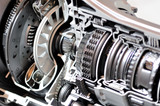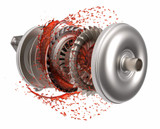TRANSFORMED: BUILDING AN AUTOMATIC FOR THE LONG HAUL
Since 1996, STREET RODDER magazine has built a new car every year and then turned Jerry Dixey loose on an unsuspecting nation to travel the highways and byways of the country to promote the hobby we all love. With all the miles covered we’ve learned a number of lessons concerning the construction of a safe, reliable car, and with the record of performance that’s been established we’d classify the endeavor as an unqualified success. This year’s car, a reproduction ’40 Ford coupe being built by Hollywood Hot Rods, will be equipped with an automatic transmission from GEARSTAR.
When automatic transmissions first began appearing in street rods there wasn’t much to choose from. Massive four-speed Hydramatics with their goofy gear spreads and two-speed Powerglides were among the most common, but today we have a host of excellent automatic overdrives to pick from. However that doesn’t mean they’re perfect. The fact is car companies are in the business to make money. That means if they can save as little as a few cents on parts that will last for a reasonable period of time (read until the warranty is up) that’s what they do. Could any OEM build a transmission, or any other component for that matter, that was virtually indestructible and would last a lifetime? Sure they could, the factory engineers have the know-how and the resources to do it, but their efforts come under the scrutiny of the bean counters that have to answer to executives who have to have an affordable product to make money for stockholders.
In terms of operation, all automatic transmissions function in the same manner in that multiple planetary gear sets are used to provide the various gear ratios plus reverse. Friction devices, bands, and clutches are applied by hydraulic pressure created by the pump and directed by the valvebody and as various portions of the gear ratios are changed. Simply put, when an automatic shifts one friction is applied and another is released. When one of the clutch packs won’t hold the transmission slips it leads to increase wear of the other components and ultimately failure of the transmission.
While it’s often east to be critical of OEM parts, the truth is street rodders often subject factory components to far more street than they were designed to endure. And even though the factories are constantly updating their products, ironically, it’s often the aftermarket that comes up with improvements the manufacturers won’t spend money on.
GEARSTAR has devoted years to finding the weaknesses in the popular automatic and spent a considerable amount of money developing the parts to correct them. These improved components increase the transmission’s capacity to handle more horsepower and improve longevity. In addition, when a transmission is ordered from GEARSTAR, the customer is asked for information about the car, including engine displacement, horsepower, torque, weight, rear gear ratio, tire size, type of speedometer drive, and the intended use of the vehicle. All these specs are then used to calibrate the transmission’s shift feel for that application.
To get an idea of what goes into a GEARSTAR transmission, Jerry Dixey grabbed his camera and headed to Akron, Ohio, to see for himself what they do. In this case the transmission parts shown are for a GM 700-R4, but same attention is given to every transmission that goes out the door (the improved parts will be on the left in all the photos). As GEARSTAR‘s owner puts it: “We build every transmission like it was going in one of our cars.” You can’t ask for more than that.
 |
Gearstar transmissions are built by one of five master technicians from start to finish. For those with cars under construction the three year/36,000-mile warranty doesn’t start until the car hits the road. |
| Gearstar has transmission cores of every description on hand. In most cases transmission shops will overhaul a transmission and only replace parts worn beyond limits. Gearstar remanufactures these gearboxes, which means virtually everything is new. |  |
 |
One of the weak points of a 700-R4 is the drive shell, during some shifts they go from engine rotational speed to a dead stop and are under terrific stress. The splines in the stockers tend o strip or break; Gearstar’s improved is hardened to eliminate the problem. |
| This is a one-way clutch, as the name implies, when necessary the spring-loaded rollers move up a ramped inner race and lock the components together in one direction and release in the other. Gearstar redesigned springs that reduce wear and improve release characteristics. |  |
 |
An improved one-way clutch inner race is also part of the package. In level III and IV transmissions for high-horsepower applications the stock-style thrust washer is replaced with a Torrington bearing. |
| Here’s a case where a factory update is a step in the wrong direction. This is a sprag, another type of one-way clutch; the new style uses a plastic cage. Gearstar installs the early version with a metal cage. |  |
 |
These are servo pistons that activate a band. The Corvette version on the left is used exclusively as it applies faster for a crisper shift. |
| To take advantage of the drum’s entire surface, Gearstar installs a wider-than-stock banc. |  |
 |
In addition to being 10 percent wider, the Gearstar band uses improved friction materials and has reinforced apply lugs. |
| This is one of the planetary gear sets from a 700-R4, the improved replacement includes five pinion gears rather than the original four and the housing is made of hardened steel rather than cast like the stocker. |  |
 |
The same improvements can be found in the 700-R4 rear planetary set, one additional pinion gear and improved endplates. |
| These are input shaft and drum assemblies; replacement shafts are heat-treated to improve their strength. |  |
 |
One change often requires another. For reliability, a reinforced drum and modified apply piston are used to go along with the stronger shaft. |
| Clutch packs are made up of alternating friction and steel discs. Gearstar installs improved friction discs and heat-treated steels. |  |
 |
Torque converters are opened up and completely remanufactured with stall speed optimized for the application. Loc-up converters are equipped with better and thicker friction materials, and in many cases additional clutch discs. |
| Every transmission is dyno tested before it’s shipped and a complete performance report is included. Transmissions are tested with AMSOIL Inc. synthetic fluid. |  |
 |
Before going into a sturdy shipping box, 3 quarts of fluid are drained. Replacement fluid is included along with a cooler, dipstick, converter dust cover, TV cable, and a mount. |



